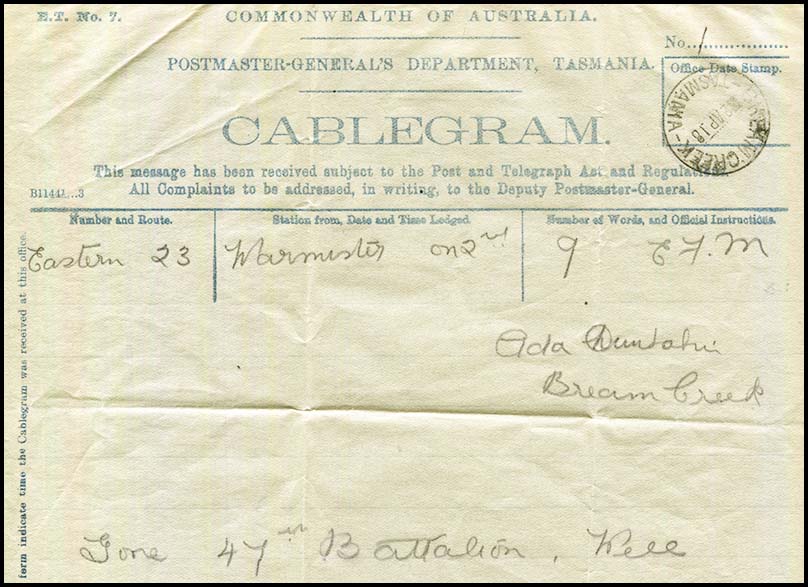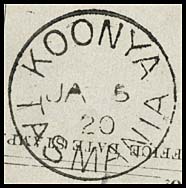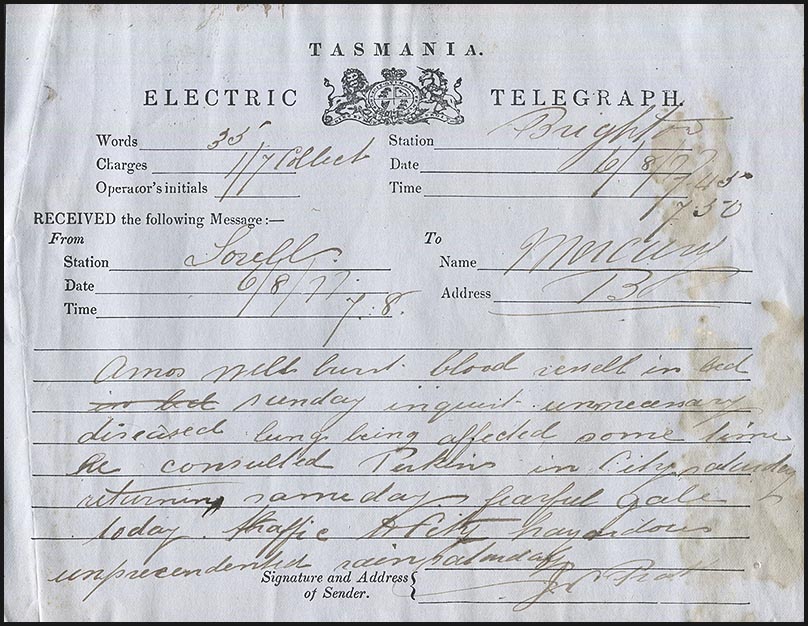Telegraph Offices: South-east region.
- Australia 1901-1988
- New South Wales
- Overview of NSW
- Telegraph lines
- Telegraph Offices
- Date stamps
- Forms
- Envelopes
- Instructional annotation
- Collect
- Delayed
- Free
- Immediate Urgent
- Reply paid
- Rates
- Stamps
- 1871 Telegraph stamps
- 1885 proposal
- 1893 proposal
- Queensland
- South Australia
- Tasmania
- Victoria
- Western Australia
- International
- Special aspects
The Telegraph Offices in this region of Tasmania are summarised in the following table:
| Apslawn | Bicheno | Bream Creek | Buckland |
| Koonya | Newtown | Richmond | Sorell |
| Spring Bay | Swansea |
|
Located between Cranbrook and Bicheno. Great Swanport operated there as a Post Office as early as 1851. The Office was later referred to as APSLEY or APSLAWN - these being the names of the two properties owned by the Lyne family. A Post Office appears to have operated at Apsley at the Railway Station at least from 1 February 1892 to 1912. It had been previosly gazetted as opening on 1 September 1890. The Telegraph Station was opened at Apslawn on 13 July 1887. |
|
Personnel. 1900: Mr. J. Lyne was the Station Master 1911-12: Mr. W. Bowker replaced Mr. Lyne. |
|
| Only manuscript cancellations are known on telegram forms from 23 January 1902. The first c.d.s. recorded is for 28 June 1927. | See mss date stamp of 19 April 1902 on TC-TO-5C. |
| The most famous resident of Apslawn was Sir William Lyne - a former Premier of New South Wales who was born in Apslawn on 6 April 1844. He was the first person to be called on to form the first Federal Ministry of the Government of Australia - ahead of Mr. Barton. | |
|
The Telegraph Office was open at Bicheno on 13 July 1887. |
|
|
|
|
|
The original settlement in this area was called the Prosser Plains. The village was then renamed Buckland about 1846 although the Buckland Inn had been constructed in 1841 and licenced in 1845. The Prosser's Plains Post Office was opened on 19 October 1838 and renamed Buckland about 1884. Meanwhile the Buckland Telegraph Office opened in 1876. It was part of the East Coast line which ran from Richmond to Swansea. The office was located on the East Coast line from Richmond to Swansea. |
| Two examples of telegrams to and from Buckland 0n 16 August 1881 and recorded on ad hoc forms (plain paper) are included elsewhere. |
|
The Post & Telegraph Office was opened as Koonya on 1 September 1897. The previous Post Office was transferred to Port Arthur in October 1853. A new office was then opened and operated as Cascades from 17 December 1884. |
|
A Type 1 circular date stamp with TASMANIA at the base:
|
Used on TI-DO-4. |
|
New Town was settled in 1804 by the first free settlers who were landed in Tasmania. The Post Office was opened on 1 January 1842 while the Telegraph Office ... |
|
Opened in January 1876. The office commenced the East Coast line from Richmond to Swansea. |
|
The Telegraph Office opened in Sorell in January 1876. The office was located on the East Coast line from Richmond to Swansea. |
| The earliest evidence of the operation of the Sorell Telegraph Office is a telegram delivery form (TC-DO-3B) used for a message sent from Sorrell to The Mercury at Brighton on 6 August 1877 concerning two news items. |
|
The Telegraph Office was opened in 19 January 1876 when communication from Hobart to Spring Bay was established. The office was located on the East Coast line from Richmond to Swansea. |
|
|
Originally called Great Swanport in the 1820s, the name was changed Waterloo Point which was the name when the first Post Office was established. Then, about 1863, the name was changed to Swansea. The Telegraph Office was opened on 3 February 1876. On 22 March 1876, the Cornwall Chronicle reported that an average of 4 telegrams per day were being sent from the Telegraph Office in Swansea. The article went on to note that:
|
|


